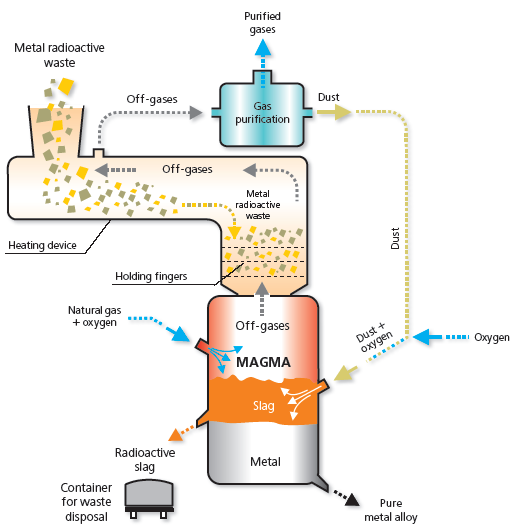The amount of solid radioactive waste (SRW) of low and average level of contamination accumulated in Russia exceeds 1 million tonnes.
Due to the forthcoming closure and dismantling of out-dated equipment of atomic power stations and nuclear fuel cycle enterprises and disposal of ships with nuclear power units, accumulation of significant amount of SRW and metal radioactive waste (MRW) is also expected in the future.
Similar situation builds up in a number of industrially developed countries.
Processing of SRW faces a number of ecological, economic and technological problems due to low efficiency of conventional technologies used for processing of SRW before its ultimate disposal.
The most economically effective way of processing of SRW is pyrometallurgical method, that enables converting of SRW to secondary SRW of lower volume (up to 30 times) and deactivating of MRW to clean metal and secondary wastes in form of radioactive slag (3-5% from original volume of MRW).
Conventional types of electric (induction, arc or plasma) melting units have a number of disadvantages: low capacity, complexity of sealing of working space, possibility of contaminated emissions to the atmosphere and formation of significant amount of secondary wastes due to quick wearing of lining.
The smelting unit MAGMA allows to carry on pyrometallurgical decontamination of solid radioactive waste continuously at considerably lower costs of processing.
In result of conducted research the Company has received positive opinion of effectiveness and feasibility from a number of respectable organizations:
- National University of Science and Technology MISIS
- JSC NIKIET
- A.Bochvar Scientific Research Institute for Inorganic Materials (VNIINM)
- Leipunsky Physics and Energy Institute
- Institute of Industrial Ecology of Ural Branch of Russian Academy of Sciencea
Solid radioactive waste processing technology
Before feeding to the unit, radioactive waste are heated in a shaft heater to temperature 600-800°С. This allows to decrease energy consumption and increase production capacity of the unit.
Radioactive waste are smelted in a liquid metal bath under oxidising conditions, which speeds up smelting, improves decontamination of metal radioactive waste and reduces dust formation. A layer of oxidised slag of low basicity with temperature 1600-1650°C is formed and permanently maintained over the metal for assimilation of radionuclides oxidised and removed from the molten metal.
Metal components (barrels, fittings, etc.) contained in solid radioactive wastes charged to the melting unit are melted and accumulated in the lined bottom of the melting unit. Radionuclides contained in metal are oxidized and transferred to the slag. In result metal is deactivated.
Decontaminated metal is released to the ladle and then out to form ingots that are further used as charge in steel production.
Slag contaminated with radionuclides is non-continuously released from the smelting unit into containers for disposal of radioactive waste. The generated oxidised slag of low basicity does not fall to pieces with time and is an ideal substance for absorption and storage of radionuclides.
The dust captured by the gas treatment system that contains radionuclides is transported by injectors to the molten slag assimilating with the slag.
Flow diagram of decontamination of solid radioactive waste

Comparative performance of radioactive metal waste disposal
|
Parameter |
MAGMA project |
MAGMA project |
|
Decontamination |
pyrometallurgical |
mechanical, chemical, |
|
Contamination level of the waste being disposed |
low, average |
low, rare - average |
|
Smelting unit type |
hermetically sealed, |
electrical induction and arc |
|
Type of operation |
continuous |
non-continuous |
|
Volume in terms of metal |
up to 20 tons |
mainly up to 5 tons |
|
Slag ratio |
0.02 - 0.03 |
0.04 - 0.05 |
|
Production capacity, tpy |
5,000 - 50,000 |
3,000 - 7,000 |
|
Consumption for smelting of 1 tonne of metal radioactive waste: natural gas, m3 oxygen, m3 electric power, kWh |
100-120 200-240 -- |
-- -- 600-800 |
|
Secondary radioactive waste produced |
slag 2-3% |
slag 4-5%, refractories 2-5%, |
|
Limitation in use of decontaminated metal |
98-99% without limitations |
10-65% without limitations |
|
Operating costs of disposal of 1 ton of |
1 100 euro |
2 000 – 8 000 euro |
